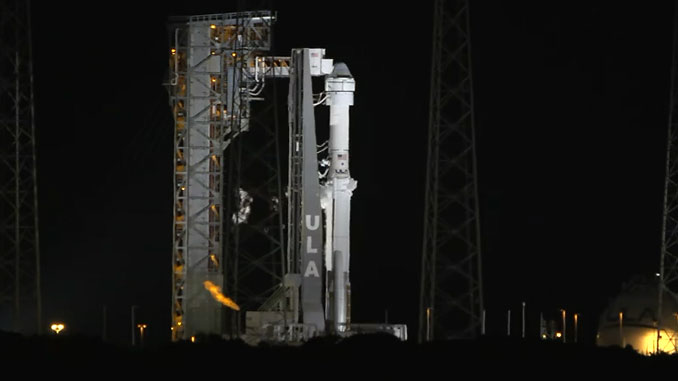
NASA is looking at the start of June for its next attempt to launch its astronauts, Butch Wilmore and Suni Williams, on board Boeing’s Starliner spacecraft. The announcement came last Wednesday night in a blog post, stating that June 1 will be the earliest that the Crew Flight Test of Starliner can begin.
The new launch date has a T-0 liftoff of 12:25 p.m. EDT (1625 UTC). There are also backup opportunities available on Sunday, June 2; Wednesday, June 5; and Thursday, June 6.
The May 6 launch date was originally scrubbed about two hours prior to launch due to an issue with an oxygen pressure release valve on the upper stage of United Launch Alliance’s Atlas 5 rocket. That issue was resolved on May 11 after rolling the rocket back to ULA’s Vertical Integration Facility and swapping it out.
[embedded content]
However, the launch delay persisted as Boeing was assessing a helium leak connected to a flange on one of the reaction control thrusters on the Starliner spacecraft’s service module. There are a series of thrusters within four chambers on the exterior of the service module called “doghouses.”
The cryogenic helium is used to pressurize the propulsion system on the service module and ensure that the propellant and oxidizer flow as needed to their respective thrusters and the launch abort engines.
The leak was initially believed to be within flight limits and wouldn’t have led to a mission scrub on May 6, which was demonstrated through a pressure test done in the VIF on May 15. But on May 17, NASA and Boeing delayed the mission until May 25, citing the need for Boeing to “develop operational procedures to ensure the system retains sufficient performance capability and appropriate redundancy during the flight.”
The weekend rolled by without any further updates and on May 21, following multiple requests from members of the press for more information, a NASA spokesperson confirmed that May 25 was off the table.
“The team has been in meetings for two consecutive days, assessing flight rationale, system performance, and redundancy. There is still forward work in these areas, and the next possible launch opportunity is still being discussed,” a NASA spokesperson said.
On May 22, NASA said in a statement that they are still continuing to asses the conditions of the leak as well as the redundancies built into Starliner. A spokesperson noted that unrelated to the helium leak, “teams are in the process of completing a follow-on propulsion system assessment to understand potential helium system impacts on some Starliner return scenarios.”
“There has been a great deal of exceptional analysis and testing over the last two weeks by the joint NASA, Boeing, and ULA teams to replace the Centaur Self Regulating Valve and troubleshoot the Starliner Service Module helium manifold leak,” said Steve Stich, manager, NASA Commercial Crew Program. “It has been important that we take our time to understand all the complexities of each issue including the redundant capabilities of the Starliner propulsion system and any implications to our Interim Human Rating Certification. We will launch Butch and Suni on this test mission after the entire community has reviewed the teams progress and flight rationale at the upcoming Delta Agency Flight Test Readiness Review.”
A press briefing is now set for Friday, May 24, at 11 a.m. EDT (1500 UTC) to discuss the work done and the path forward to launch. Williams and Wilmore continue to remain in quarantine in Houston, Texas, and have spent the additional weeks conducting further simulator training to prepare for the mission.
[embedded content]
Boeing’s Starliner spacecraft was chosen by NASA alongside SpaceX’s Dragon capsule to ferry its astronauts to and from the International Space Station. But Starliner has faced a number of unfortunate hurdles, amid it launch campaign.
The 2019 uncrewed Orbital Test Flight ran into software and communication issues, which led to Boeing footing the bill for a second OFT mission in 2022. The flight was able to safely make it to the ISS and back, but issues were discovered once it was back on the ground.
The CFT mission is designed to demonstrate some of the manual capabilities of the spacecraft that could be used, if the automated system were to have an in-flight issue. A successful CFT would pave the way for the first, full crew rotation mission, Starliner-1, which is currently aiming for launch in the spring of 2025.
- SEO Powered Content & PR Distribution. Get Amplified Today.
- PlatoData.Network Vertical Generative Ai. Empower Yourself. Access Here.
- PlatoAiStream. Web3 Intelligence. Knowledge Amplified. Access Here.
- PlatoESG. Carbon, CleanTech, Energy, Environment, Solar, Waste Management. Access Here.
- PlatoHealth. Biotech and Clinical Trials Intelligence. Access Here.
- Source: https://spaceflightnow.com/2024/05/23/nasa-boeing-and-ula-announce-june-1-as-new-target-date-for-starliners-crew-flight-test/



